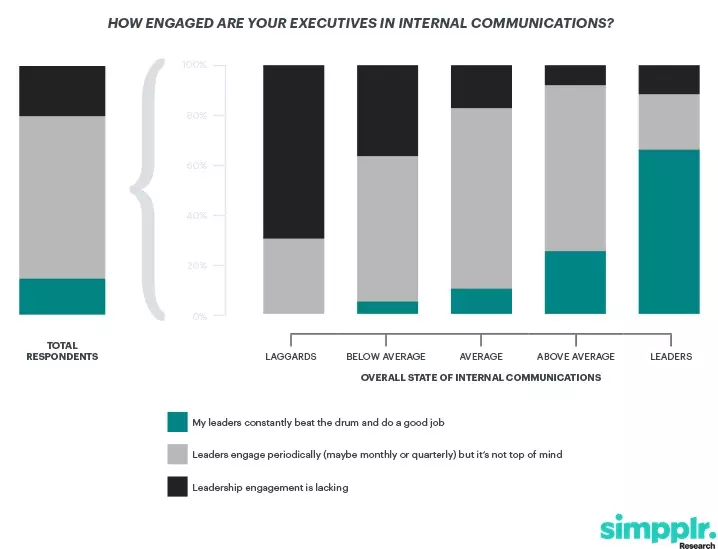Simpplr Research just concluded our latest report, State of Internal Communications 2019. The goal is to gauge the state of the profession and gain insights on how to improve internal communications and drive internal communications success. Every week, Simpplr Research will be sharing the most significant findings from our State of Internal Communications report. This week, Simpplr Research explores the vital connection between internal communications and executive involvement.
Chart of the week: Executive involvement is crucial for internal communications success


Data Analysis: Data for this chart was collected via a random sample survey of 411 corporate communications practitioners. The survey asks respondents to rate their state of internal communications on a scale of 1-5, with 5 indicating a great internal communications program and 1 indicating a severely lacking internal communications program. Furthermore, the survey asked respondents about the level of involvement of executives in the organization’s internal communications program. The results of both questions are compared and illustrated above. The breakdown shows that organizations, where executives are highly involved in internal communications, have on average, higher ratings compared to organizations where executives are disengaged or lacking involvement. This trend is precisely monotonic, with increased executive participation associated with increased internal communications strength at every level. The upper breakdown further shows this trend; leaders in internal communications have higher executive involvement. The large sample size gives statistical power to test this difference. The difference in the average state of internal communication between organizations with extensively involved executives and uninvolved executives is significant at the 0.05 alpha level.
Impact of leadership involvement
Let’s explore the significance of the charts above. Based on the data collected, leading internal communications (IC) programs have extremely engaged leadership compared to the rest of the surveyed organizations.
The overall sentiment of the state of internal communications success reflects the lack of leadership involvement in internal communications across all organizations except for the organizations with leading IC programs. The contrast is most stark between lagging and leading programs. However, the lack of executive engagement is consistent across the board, except for leaders. The lack of leadership involvement can either mean (1) leaders do not understand the value of their engagement in IC or (2) internal communications need to do a better job at articulating IC impact on the overall organization.
It’s not uncommon that IC receives management’s blessing, but eventually leaves the function aside to rot. But merely getting executive buy-in isn’t enough. Based on the survey results, internal communicators need to do a better job in helping executives to understand the importance of IC as a function and how it impacts strategic initiatives. The data shows that it is simply not enough for organizations to create internal communication programs and expect desirable outcomes as it pertains to executive participation and employee engagement.
Internal communications is an extension of leadership
Instead, executives need to view internal communications as an extension of themselves. Whether we like it or not, leadership defines behaviors and values. Executives need to be accountable for company culture because it trickles down and impacts every single employee. It’s challenging for internal communicators to enforce culture without leadership involvement because IC is limited to what they can accomplish since employee engagement aligns closely with leadership. IC’s purpose is to align their function around employee engagement, and one of the top key drivers of employee engagement is alignment. Company alignment and internal communications success refers to making sure that employees and executives are on the same page. To improve employee engagement, executives need to be extremely clear on corporate priorities. They need to remind employees and chorale them on company goals.
Executives need to focus on alignment
According to Simpplr Research’s State of Internal Communications report, most companies struggle with alignment. On average, only about 30% of employees across all organizations can recite goals well across the board. We’ve pinpointed the key drivers and worked backward to understand which areas to focus on to maximize efforts to improve your internal communications program. To engage the organization, employees need to know how their contribution impacts the broader organization. Organizational alignment is only possible if leaders are involved in internal communications and communicate their vision and strategy consistently throughout the year.
Download the State of Internal Communications survey results
To dive deeper into our research, download the State of Internal Communications report here.

















